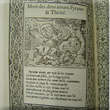
What is Literature?

Name of Assignment: B.1. Essay 1 |
Draft Due: 6 July 2007 (2 % of final grade) |
In an essay of 750 words (or 3 printed pages), write an explication or analysis that responds to one of the questions below and draws its evidence from one of the following texts: Dave Eggers, “She Needed More Nuance”; Gilles Vigneault, “The Wall”; Thomas King, “Borders”; Margaret Atwood, “Marrying the Hangman”; Ovid, “Pyramus and Thisbe.”
Option 1. What is this doing?
Option 2. Why do I have this response?
Option 3. Why does Wendy Berlin need more nuance?
The purpose of this assignment is to provide you with the opportunity…
1. …to reflect on what literature or what it does.
2. …to become familiar with different arguments you can make about literature and the evidence you might use to support these arguments.
3. …to review and practice the process of reading and writing about literature: 1. Pre-writing (reading, annotating, etc.); 2. Developing a thesis and writing a draft; 3. Revising; and 4. Editing.
4. …to identify aspects of your writing that are particularly strong or that need further attention.
1. I expect you to read all of the expectations and requirements for this assignment and to ask questions if you have any problems understanding it. You may ask questions in class, during office hours, by telephone, or email.
2. I expect that you will develop a thesis and argue it, drawing evidence from the text under your consideration and using class discussions to help narrow your topic.
3. I expect that you will use the peer review workshop to refine your own writing and to help someone else do the same.
4. I expect you to use terms that you understand and to understand the terms that you use.
5. I expect that both your draft and final essay will follow the Remarks about Manuscript Form (SGWL 280-285).
Draft (2 % of final grade): For more information about this part of your grade, please consult the course outline under Graded Writing Assignments. Credit for this part of the assignment is based on a draft essay that follows the Remarks about Manuscript Form (SGWL 280-285) brought to class for peer review on 6 July 2007. Although this part of the assignment will not be formally graded, your effort at this stage will likely indirectly affect your grade. Drafts that are deemed to be inadequate will receive no credit.
Final (3 % of final grade): Your final paper is due in or before class on 10 July 2007. Your final paper must be accompanied by a photocopy of your draft (keep your copy just in case). Before submitting your final paper, please review SGWL 46-51.
Your assignment’s format should make it as easy to read and to mark as possible. Your margins should be 2.54 cm (1 inch) on all sides. For your font, use either Garamond or Times New Roman in 12 point. If you are following these guidelines and double-spacing your text, I assume an average of 250 words per page (although your word count will tell you that you have slightly more than this). It is not a good idea to use a larger or smaller font to adjust for verbosity or a lack thereof: this practice will not make your assignment more pleasant to read or—perhaps more importantly—to mark. Use black ink on standard weight 8 1/2" X 11" white or recycled paper. In the first four lines at the top left of your paper, write your name, my name, the course name and number, and the due date of the assignment. Insert page numbers in the top right hand corner of each subsequent page, including your name with it (you may omit including this information on the first page).
Your paper should have a clearly identified title on its first page. Use your title effectively: it should indicate to your reader what text you will consider and what your approach will be. Titles can often tie into the concluding sentence for rhetorical impact, though this should never compromise clarity.
Papers at this level should strive for clarity and precision. They should present an organized argument through clearly articulated paragraphs, which should be marked by indentation. The first paragraph should grab your reader’s attention while introducing your topic and approach. It should provide information relevant to your particular argument.
Week 1 |
|
What is Literature? |
03-Jul |
|
Dave Eggers, “She Needed More Nuance” |
|
|
SGWL 1-11 (Reading and Responding, Meaning and Significance) |
04-Jul |
|
Gilles Vignealt, “The Wall”; Thomas King, “Borders” |
|
|
SGWL 12-30 (Writing a Draft) |
05-Jul |
|
Margaret Atwood, “Marrying the Hangman”; Ovid, “Pyramus and Thisbe” |
|
|
SGWL 31-51 (Explication and Analysis) |
06-Jul |
B1 (D) |
Paper 1 (Draft) Due. Writing Workshop. |
|
|
SGWL 65-76(What is Literature?); SGWL 254-285 (Grammar, Syntax, Style, and Format) |
|
|
|
Week 2 |
|
What is Criticism? (Part 1) |
09-Jul |
|
J. K. Rowling, Harry Potter and the Philosopher's Stone |
|
|
SGWL 77-103 (What is Interpretation? What is Evaluation?) |
10-Jul |
B1 (F) |
J. K. Rowling, Harry Potter and the Philosopher's Stone |
|
|
SGWL 104-125 (Writing About Literature: An Overview) |